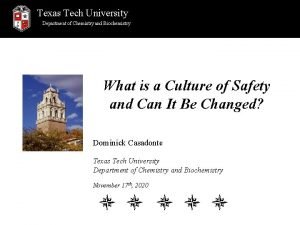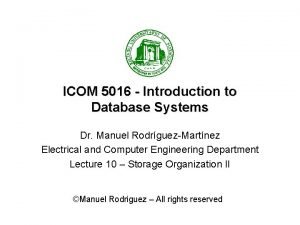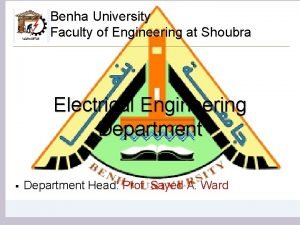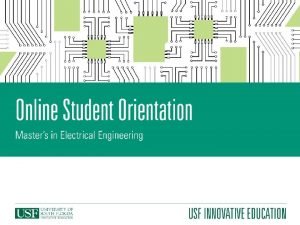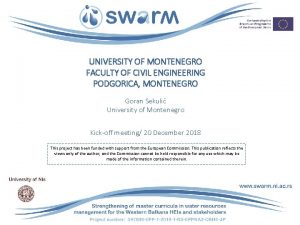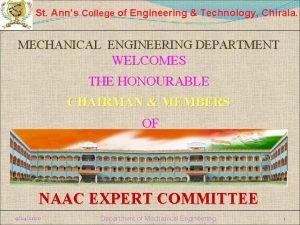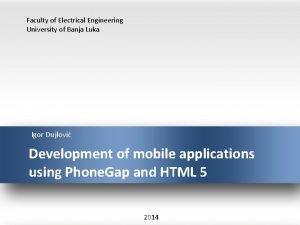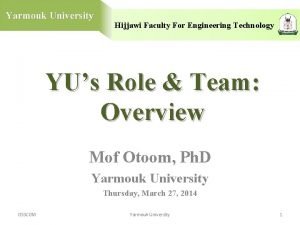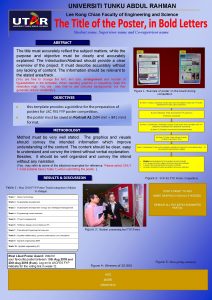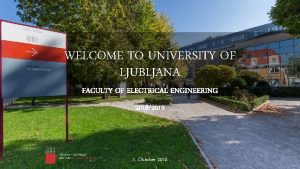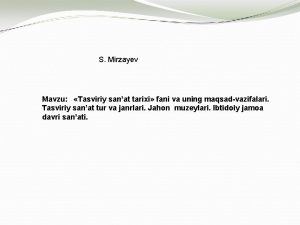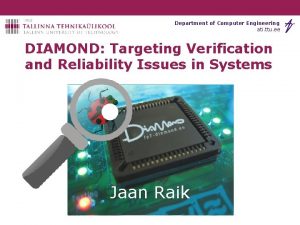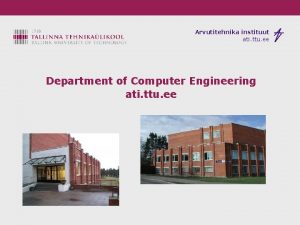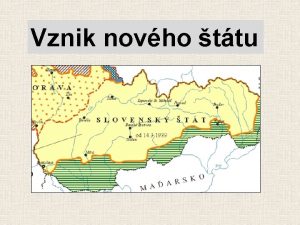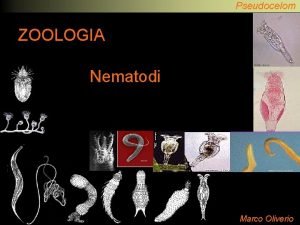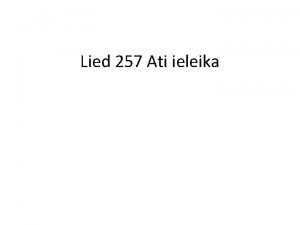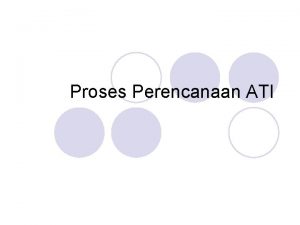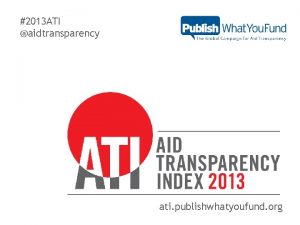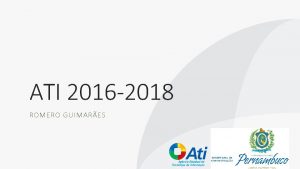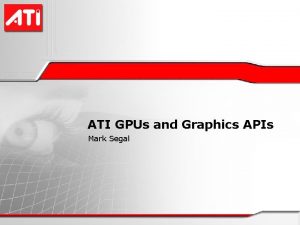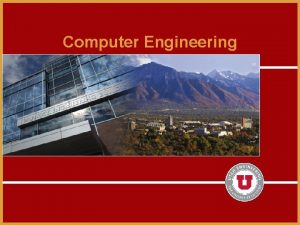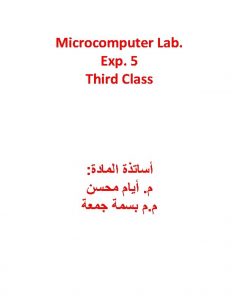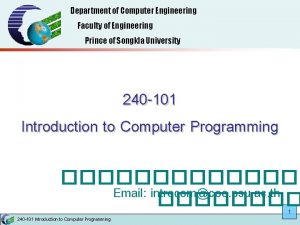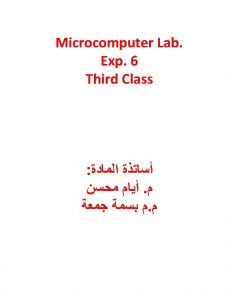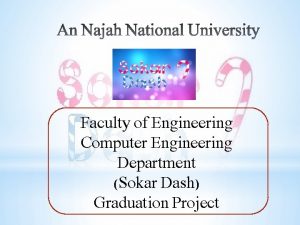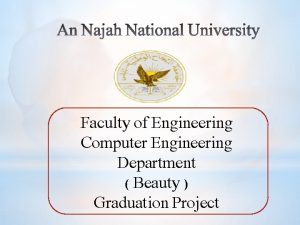Department of Computer Engineering ati ttu ee Faculty


























- Slides: 26

Department of Computer Engineering ati. ttu. ee Faculty of Information Technology and interdisciplinary research in the areas of electronic systems and biomedical engineering Gert Jervan Tallinn University of Technology Department of Computer Engineering

© Gert Jervan Mission ü The Faculty of Information Technology has evolved from the Faculty of Electrical Engineering founded in 1965 ü The main objective is: n to carry out the university objectives n in the faculty´s domain study, research and development n in the fields of • computer science, informatics and software engineering, • computer and systems engineering, • radio and communication engineering, • electronics, and • other fields of information technology all over the university 2

© Gert Jervan Departments • Computer Engineering • Computer Science • Informatics • Computer Control • Electronics • Radio and Communication Engineering 3

© Gert Jervan Study domain, degree programmes ü 3+2 system: n Bachelor degree: 3 years 180 ECTS n Master degree: 2 years 120 ECTS ü Doctoral degree: 4 years ü Bachelor & Master degrees ü ECTS will be applied in 2009 240 ECTS n Business Information Technology n Computer and Systems Engineering n Electronics and Bionics n Informatics n Telecommunication Ph. D degree n Information and Communication Technology 4

© Gert Jervan Students - 2008 5

© Gert Jervan Graduates - 2008 6

© Gert Jervan Academic Staff ü ü Teaching staff: n 20 professors (average 53 years) n 19 ass. professors (average 57 years) n 14 university lecturers (average 43 years) n 27 teaching assistants (average 33 years) Research staff: n 18 senior researchers (average 43 years) n 24 researchers (average 33 years) 7

© Gert Jervan Collaboration in Estonia ü ü Estonian Association of ITT n feedback from industrial community to improve teaching n direct collaboration in curricula development n student placements in the industry R&D in cooperation with industry n With more than 15 -20 companies in Estonia • AS Artec Group (the 10 th place at Central European Technology Fast 50 program) • National Semiconductors Estonia • ARSmicro (Fincitec) • Ericsson Estonia • EMT (telecom), Elcoteq (EMS), LDI (diagnostic instr. ). . . 8

© Gert Jervan International Cooperation ü International cooperation is going on with world leading industrial companies like St. Jude Medical, Boston Scientific, National Semiconductor, Analog Devices, TDI Inc, Göpel Electronic, STMicroelectronics, Aerie. Logic, Trans. Eda, . . . ü And with very many universities: n Helsinki University of Technology (Finland), Royal Institute of Technology Stockholm (Sweden), Linköping Univeristy (Sweden), Darmstadt University of Technology (Germany), University of Saarland (Germany), Turku University (Finland), TIMA Labs (France), University of Torino (Italy), University of Verona (Italy), PUCRS (Brazil), . . . 9

© Gert Jervan Spin-Off Companies ü Spin-off companies developed by the faculty staff members n Ahero OÜ – development and production of sonars n Comptuur OÜ – development of information systems n IB Krates OÜ – industrial control and information systems n Rantelon OÜ – design and production of radioelectronics systems n Smartimplant OÜ – biomedical development projects n Testonica Lab OÜ – testing and test generation for electronic systems 10

© Gert Jervan Infrastructure Development Project ü "Embedded Systems and Components“ • Time span: 2006 -2008 • Funded from the European Structural Funds • Total investment ca 4 M EUR • 101 workplaces, of what 54 new and 47 modernized n New laboratories: • MINAKO - Laboratory of Micro- and Nanoelectronic Components • SIE - Laboratory of Communicative Electronics • ASSA - Laboratory of Synthesis and Analysis of Embedded Systems 11

© Gert Jervan CEBE ü Centre for Integrated Electronic Systems and Biomedical Engineering - CEBE ü CEBE is composed of three research groups: ü n Design of Reliable Embedded Systems (RES) TTÜ, Dept. of Computer Engineering, Raimund Ubar n Electronic Components and Subsystems for Mission Critical Embedded Systems (EMBEL) TTÜ, Dept. of Electronics, Mart Min n Interpretation of Biosignals in Biomedical Engineering (BME) TTÜ, Technomedicum, Ivo Fridolin About 80 reseachers and Ph. D students 12

© Gert Jervan CEBE ülevaade 13 13

© Gert Jervan CEBE International Cooperation ü Europrojects (7) n FP 5: Verification and Validation of Embedded System Design Workbench - VERTIGO (2006 -2008) n FP 6: Knowledge Environment for Interacting Robot Swarms ROBOSWARM (2006 -2009) n FP 7: Smart Museum: Cultural Heritage Knowledge Exchange Platform - SMARTMUSEUM (2008 -2010) n FP 7: Centre of Research Excellence in Dependable Embedded Systems - CREDES (2008 -2010) n FP 7: Integration of Fluidic and Electric Microscaled Principles - INFLUEMP (2007 -2010) n EUREKA: ITEA 2 project D-MINT with ABB, DAIMLER, VTT n OLAF: Study on the Euro Coin calibration procedure for obtaining certified reference standards - EUROCOIN 14

© Gert Jervan Embedded Systems Embedded systems General purpose systems Microprocessor market shares 99% 1% Communication-intensive heterogeneous real-time systems 15

© Gert Jervan RES: Research Fields ü Dependable Digital Systems (ATI, Raimund Ubar) n Design and Synthesis n Verification and Debugging n Testing and Fault Diagnosis n Design for Dependability 16

© Gert Jervan Power Density (W/cm 2) 10000 Rocket Nozzle 1000 Nuclear Reactor 100 8086 10 4004 Hot Plate P 6 8008 8085 Pentium® proc 386 286 486 8080 1 1970 1980 1990 Year 2000 Courtesy, Intel 2010 17

© Gert Jervan Thermal map: 1. 5 GHz Itanium-2 Cache Tem p (o. C) Execution core 120 o. C [Source: Intel Corporation and Prof. V. Oklobdzija] 18

© Gert Jervan The result. . . 19

© Gert Jervan EMBEL: Research Fields Personal and body area electronics We make electronics disappear, embedding it into your clothes and bed, under the skin, into your body and organs – lungs, heart, brain, etc. . . and helping so your healing and making your life more enjoyable when your body organs are injured or weary of life 20

© Gert Jervan EMBEL: Research Fields Body area sensor network • BAN – Body Area Network • PAN – Personal Area Network • Conductive communication through tissue as via “liquid wire” • Near-field wireless com-munications (400 MHz, MICS) üImpedance of the communi-cation media (body) against the electromagnetic field characterizes properties of the body üTissue impedance exposes as a biosensing parameter 21

© Gert Jervan BME: Research Fields Tensio. Trace – Device for continuous beat-to -beat blood pressure measurements. The theoretical background of the method based on study results of Department of Biomedical Engineering and Estonian Institute of Cardiology. Advances of the method: 1) Simple measurement procedure; 2) Short measurement time (output for every heart beat); 3) Fully non-invasive and patient-friendly method (because we use light). 22

© Gert Jervan BME: Research Fields ü Brain research: understanding and protection of the brain n Interpretation of the EEG signal: • New methods of EEG analysis sensitive to reveal small alterations in the signal hidden in natural variability of the EEG; • Effect of modulated microwave radiation on the brain – harmful or healing; • EEG-based parameters for distinction of alterations characteristic for mental disorder (depression) 23

© Gert Jervan BME: Research Fields ü Prediction of sudden cardiac death (SD) n European Union - 3000 cases per day/1, 1 million per year n USA – 1500 cases per day/500 000 per year n Professional help is still possible during the first 4 -5 min after SD appearance n Prediction is important! • Parameters: Non-invasive VR parameters, physiological, biochemical and radioimmunological investigations and assessing QT interval parameters 24

© Gert Jervan BME: Research Fields The clinical experiments at the Department of Dialysis and Nephrology, North-Estonian Medical Centre Dia. Sens, LDIAMON AS 25

Department of Computer Engineering ati. ttu. ee Thank You! Gert Jervan Tallinn University of Technology Department of Computer Engineering
 Texas tech departments
Texas tech departments Tum department of electrical and computer engineering
Tum department of electrical and computer engineering Computer engineering department
Computer engineering department Nit calicut chemistry
Nit calicut chemistry System architecture example
System architecture example Lee kong chian faculty of engineering and science
Lee kong chian faculty of engineering and science Czech technical university in prague civil engineering
Czech technical university in prague civil engineering Faculty of engineering shoubra
Faculty of engineering shoubra Feup university of porto
Feup university of porto Usf electrical engineering faculty
Usf electrical engineering faculty Civil engineering faculty
Civil engineering faculty St ann's engineering college chirala faculty
St ann's engineering college chirala faculty Faculty of electrical engineering
Faculty of electrical engineering Hijjawi faculty for engineering technology
Hijjawi faculty for engineering technology Lebanese university faculty of engineering
Lebanese university faculty of engineering Clemson university electrical engineering
Clemson university electrical engineering Lee kong chian faculty of engineering and science
Lee kong chian faculty of engineering and science Faculty of mechanical engineering thammasat university
Faculty of mechanical engineering thammasat university Mun engineering complementary studies
Mun engineering complementary studies Fe spletna učilnica
Fe spletna učilnica Bridgeport engineering department
Bridgeport engineering department University of bridgeport computer engineering
University of bridgeport computer engineering Mch fsu
Mch fsu Ucl meng computer science
Ucl meng computer science Brown university computer science
Brown university computer science Fecri ati kütüphanesi eserleri
Fecri ati kütüphanesi eserleri Grafika san'ati turlari
Grafika san'ati turlari
